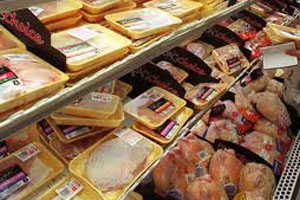FSA launches new plan to tackle campylobacter

Reducing cases of campylobacter is the FSA’s top food safety priority but monitoring carried out by the FSA shows there is no evidence of change in the proportion of the most highly contaminated chickens since 2008.
An FSA survey of chicken on sale in the UK (2007/8) indicated that 65% of chicken on sale in shops was contaminated with campylobacter. The FSA has now outlined a refreshed strategy to reduce the number of people getting ill from campylobacter.
The FSA has outlined how it will improve the amount and quality of information about campylobacter levels that is available at all stages of the supply chain, to support and incentivise more effective risk management; address regulatory barriers to the adoption of safe and effective technological innovations for reducing campylobacter risks at all stages in the food supply chain; work with local government partners and others to raise awareness of campylobacter and ensure that food businesses using chilled chicken are aware of the risks and managing them appropriately; continue and increase our support to research programmes into vaccination and other possible long term interventions to address the issue and drive changes in behaviour and approach, using tools including regulation if appropriate.
The FSA expects industry to focus its actions to continue to improve the effectiveness of biosecurity measures on farms to prevent flock colonisation with campylobacter; ensure that steps involved in slaughter and processing are effective in preventing contamination of carcasses; continue to work on packaging and other initiatives that reduce cross contamination in the consumer and food service kitchen; and develop and implement new interventions that reduce contamination when applied at production scale.
Catherine Brown, FSA Chief Executive, said: ‘What we have proposed in this paper is a shift in culture and a refocusing of effort by both government and the food industry to tackle this persistent and serious problem. While we remain committed to joint working with industry we want to encourage and see producers, processors and retailers treat campylobacter reduction not simply as a technical issue but as a core business priority – and I see some encouraging signs of that happening.
‘I feel that because this is a complex and difficult issue there has tended to be an acceptance that a high level of contamination will inevitably occur and that there’s little that can be done to prevent it. The FSA doesn’t believe this is the case and this paper sets out how together we can make progress towards reducing the number of people who get ill from campylobacter.”
FSA monitoring results show there is no evidence of a change in the proportion of most highly contaminated birds since 2008. Samples for this monitoring are taken from chickens at the end of processing (post-chill) in UK slaughterhouses and tested to determine the level of campylobacter present on the skin. Results are classified into 3 bands of contamination, which correspond to less than 100 colony forming units/gram (cfu/g), between 100 and 1000cfu/g and more than 1000cfu/g.
The target, to reduce the percentage of chickens with the highest levels of contamination to 10% by 2015, was agreed and published in 2010 by the industry/government Joint Working Group on campylobacter.













